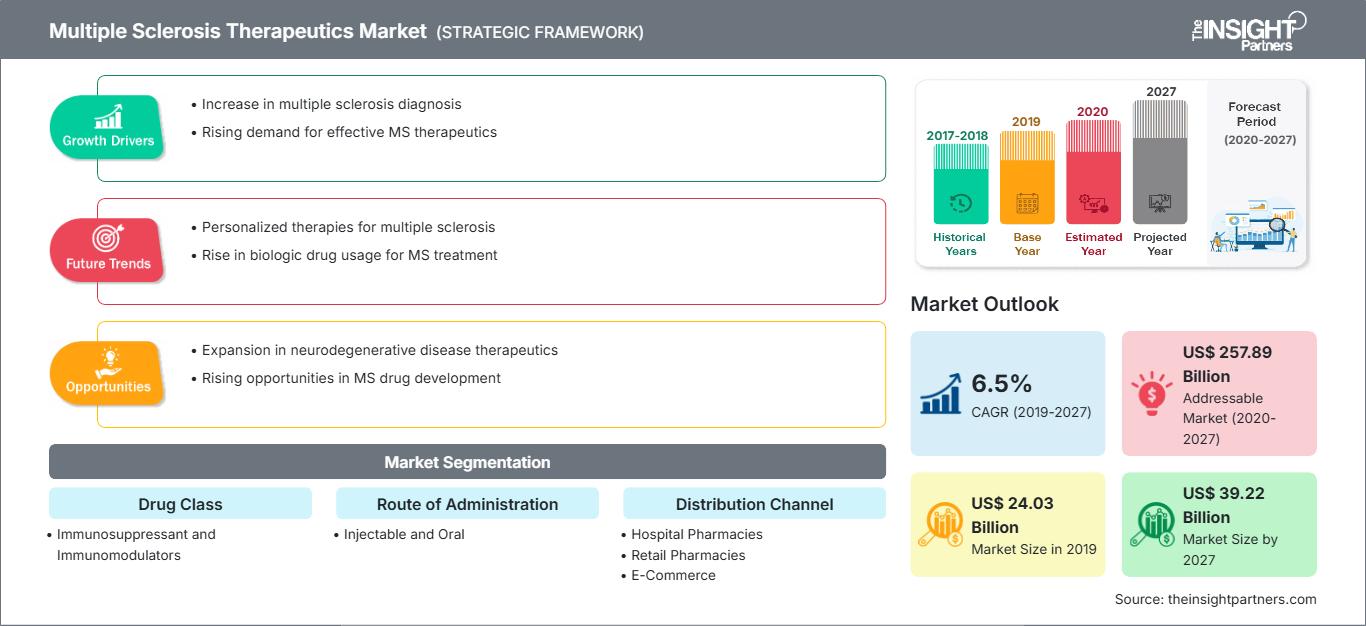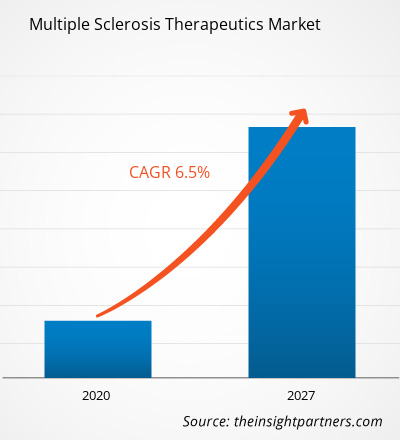Il mercato delle terapie per la sclerosi multipla è stato valutato a 24.026,90 milioni di dollari nel 2019 e si prevede che raggiungerà i 39.223,59 milioni di dollari entro il 2027; si prevede una crescita a un CAGR del 6,5% dal 2020 al 2027.
La sclerosi multipla (SM) è una malattia autoimmune che colpisce il sistema nervoso centrale. Il sistema immunitario attacca i nervi, causando problemi di comunicazione tra il cervello e il resto del corpo. Immunosoppressori e immunomodulatori, insieme alla fisioterapia, sono ampiamente utilizzati per il trattamento della SM.
L'ambito del mercato delle terapie per la sclerosi multipla include la classe di farmaci, la via di somministrazione, il canale di distribuzione e la regione. Il mercato delle terapie per la sclerosi multipla viene analizzato in base a regioni come Nord America, Europa, Asia-Pacifico, Medio Oriente e Africa e Sud e Centro America. Il rapporto offre approfondimenti e analisi approfondite del mercato delle terapie per la sclerosi multipla, ponendo l'accento su vari parametri, quali tendenze di mercato, progressi tecnologici, dinamiche di mercato e analisi del panorama competitivo dei principali attori del mercato in tutto il mondo.
Personalizza questo rapporto in base alle tue esigenze
Potrai personalizzare gratuitamente qualsiasi rapporto, comprese parti di questo rapporto, o analisi a livello di paese, pacchetto dati Excel, oltre a usufruire di grandi offerte e sconti per start-up e università
Mercato delle terapie per la sclerosi multipla: Approfondimenti strategici

-
Ottieni le principali tendenze chiave del mercato di questo rapporto.Questo campione GRATUITO includerà l'analisi dei dati, che vanno dalle tendenze di mercato alle stime e alle previsioni.
La sclerosi multipla è una malattia cronica che colpisce il cervello, il midollo spinale e i nervi ottici. I sintomi della sclerosi multipla includono debolezza, ansia, alterazioni del gusto, riduzione della sensibilità e visione offuscata o perdita della vista. Altri sintomi sono stitichezza, rigidità muscolare, depressione, difficoltà di pensiero e problemi urinari.
Gli studi suggeriscono un aumento della prevalenza della sclerosi multipla in tutto il mondo. Ad esempio, secondo uno studio della National Multiple Sclerosis Society del 2017, circa 1 milione di adulti (fino a 913.925) vivevano con la SM negli Stati Uniti. Nel 2010, la prevalenza stimata della malattia era di 309 casi ogni 100.000 persone, ovvero 727.344 adulti soffrivano di SM. Inoltre, secondo il governo canadese (stime del 2014-2015), oltre 77.000 canadesi convivono con la sclerosi multipla, di cui 3/4 sono donne.
Inoltre, la Multiple Sclerosis Society ha stimato che circa 110.000 persone soffrissero di questa condizione nel Regno Unito nel 2018. Ha anche affermato che la SM ha una prevalenza più che doppia nelle donne rispetto agli uomini. Anche il numero di nuovi pazienti diagnosticati ogni anno è in aumento: è aumentato da 5.000 nel 2017 a 6.700 nel 2018.
Pertanto, la crescente prevalenza della sclerosi multipla sta trainando il mercato delle terapie per la sclerosi multipla.
Approfondimenti basati sulla classe di farmaci
In base alla classe di farmaci per la sclerosi multipla, il mercato delle terapie per la sclerosi multipla è segmentato in immunosoppressori e immunomodulatori. Nel 2019, il segmento degli immunomodulatori ha rappresentato una quota maggiore del mercato. La crescita di questo segmento è attribuibile al lancio di nuovi farmaci generici e all'aumento dell'adozione di immunomodulatori nel trattamento della SM. È probabile che il segmento degli immunosoppressori registri un CAGR più elevato durante il periodo di previsione.
Approfondimenti basati sulla via di somministrazione
In termini di via di somministrazione, il mercato delle terapie per la sclerosi multipla è segmentato in iniettabili e orali. Il segmento iniettabile ha detenuto una quota maggiore del mercato nel 2019 e si prevede che lo stesso segmento registrerà un CAGR più elevato durante il periodo di previsione.
Approfondimenti basati sul canale di distribuzione
In base al canale di distribuzione, il mercato delle terapie per la sclerosi multipla è segmentato in farmacie ospedaliere, farmacie al dettaglio ed e-commerce. Il segmento delle farmacie ospedaliere ha detenuto la quota di mercato maggiore nel 2019 e si prevede che il segmento dell'e-commerce registrerà il CAGR più elevato del mercato durante il periodo di previsione.
La pandemia di COVID-19 è diventata la sfida più significativa a livello mondiale. Questa sfida sarà preoccupante soprattutto nei paesi in via di sviluppo, poiché porterà a una riduzione delle importazioni a causa delle interruzioni del commercio globale. Ad oggi non è stato ancora individuato un trattamento definitivo contro il COVID-19. I pazienti con gravi patologie, come malattie neurologiche e altre, stanno assistendo a ritardi nel trattamento di tali patologie croniche. Le interruzioni della catena di approvvigionamento associate a questa situazione pandemica influenzeranno in ultima analisi le vendite dei prodotti per un breve periodo. Tuttavia, la fornitura di farmaci per la SM è stata continua durante la pandemia, poiché le farmacie hanno potuto aprire durante il lockdown. Diverse aziende stanno riducendo le loro attività di sperimentazione clinica e ritardando il lancio dei prodotti in risposta alla pandemia di COVID-19. Ad esempio, Bristol-Myers Squibb ha ritardato il lancio del suo farmaco per la sclerosi multipla Zeposia (ozanimod) a causa dello scoppio della pandemia di COVID-19.
Il lancio di prodotti e le strategie di espansione sono comunemente adottati dalle aziende per espandere la propria presenza a livello mondiale e soddisfare la crescente domanda. Queste strategie sono comunemente adottate dagli operatori del mercato per ampliare il proprio portafoglio prodotti.
Gli operatori del mercato che operano nel mercato delle terapie per la sclerosi multipla hanno adottato la strategia dell'innovazione di prodotto per soddisfare la mutevole domanda dei clienti in tutto il mondo, il che consente loro anche di mantenere il proprio marchio a livello globale.
Approfondimenti regionali sul mercato delle terapie per la sclerosi multipla
Le tendenze regionali e i fattori che influenzano il mercato delle terapie per la sclerosi multipla durante il periodo di previsione sono stati ampiamente spiegati dagli analisti di The Insight Partners. Questa sezione illustra anche i segmenti e la geografia del mercato delle terapie per la sclerosi multipla in Nord America, Europa, Asia-Pacifico, Medio Oriente e Africa, America meridionale e centrale.
Ambito del rapporto di mercato sulla terapia della sclerosi multipla
| Attributo del rapporto | Dettagli |
|---|---|
| Dimensioni del mercato in 2019 | US$ 24.03 Billion |
| Dimensioni del mercato per 2027 | US$ 39.22 Billion |
| CAGR globale (2019 - 2027) | 6.5% |
| Dati storici | 2017-2018 |
| Periodo di previsione | 2020-2027 |
| Segmenti coperti |
By Classe di farmaci
|
| Regioni e paesi coperti |
Nord America
|
| Leader di mercato e profili aziendali chiave |
|
Densità degli operatori del mercato delle terapie per la sclerosi multipla: comprendere il suo impatto sulle dinamiche aziendali
Il mercato dei prodotti terapeutici per la sclerosi multipla è in rapida crescita, trainato dalla crescente domanda degli utenti finali, dovuta a fattori quali l'evoluzione delle preferenze dei consumatori, i progressi tecnologici e una maggiore consapevolezza dei benefici del prodotto. Con l'aumento della domanda, le aziende stanno ampliando la propria offerta, innovando per soddisfare le esigenze dei consumatori e sfruttando le tendenze emergenti, alimentando ulteriormente la crescita del mercato.

- Ottieni il Mercato delle terapie per la sclerosi multipla Panoramica dei principali attori chiave
- Immunosoppressori
- Immunomodulatori
Per via di somministrazione
- Iniettabili
- Orali
Per canale di distribuzione
- Farmacie ospedaliere
- Farmacie al dettaglio
- E-commerce
Per area geografica
- Nord America
- Stati Uniti
- Canada
- Messico
- Europa
- Francia
- Germania
- Italia
- Regno Unito
- Spagna
- Resto d'Europa
- Asia Pacifico (APAC)
- Cina
- India
- Sud Corea
- Giappone
- Australia
- Resto dell'Asia Pacifica
- Medio Oriente e Africa (MEA)
- Sudafrica
- Arabia Saudita
- Emirati Arabi Uniti
- Resto del Medio Oriente e Africa
- Sud America (SAM)
- Brasile
- Argentina
- Resto del Sud America
Profili aziendali
- Merck & Co., Inc.
- Novartis AG
- Bayer AG
- Sanofi
- Bristol-Myers Squibb Company
- Horizon Therapeutics plc.
- TEVA PHARMACEUTICAL INDUSTRIES LTD
- Takeda Pharmaceutical Company Limited
- F. HOFFMANN-LA ROCHE LTD.
- Biogeno
- Analisi storica (2 anni), anno base, previsione (7 anni) con CAGR
- Analisi PEST e SWOT
- Valore/volume delle dimensioni del mercato - Globale, Regionale, Nazionale
- Industria e panorama competitivo
- Set di dati Excel
Report recenti
Testimonianze
Motivo dell'acquisto
- Processo decisionale informato
- Comprensione delle dinamiche di mercato
- Analisi competitiva
- Analisi dei clienti
- Previsioni di mercato
- Mitigazione del rischio
- Pianificazione strategica
- Giustificazione degli investimenti
- Identificazione dei mercati emergenti
- Miglioramento delle strategie di marketing
- Aumento dell'efficienza operativa
- Allineamento alle tendenze normative






















 Ottieni un campione gratuito per - Mercato delle terapie per la sclerosi multipla
Ottieni un campione gratuito per - Mercato delle terapie per la sclerosi multipla